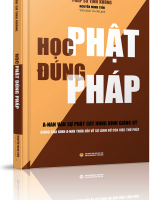Ai sống một trăm năm, lười nhác không tinh tấn, tốt hơn sống một ngày, tinh tấn tận sức mình.Kinh Pháp cú (Kệ số 112)
Người ta vì ái dục sinh ra lo nghĩ; vì lo nghĩ sinh ra sợ sệt. Nếu lìa khỏi ái dục thì còn chi phải lo, còn chi phải sợ?Kinh Bốn mươi hai chương
Hãy sống như thế nào để thời gian trở thành một dòng suối mát cuộn tràn niềm vui và hạnh phúc đến với ta trong dòng chảy không ngừng của nó.Tủ sách Rộng Mở Tâm Hồn
Đối với người không nỗ lực hoàn thiện thì trải qua một năm chỉ già thêm một tuổi mà chẳng có gì khác hơn.Sưu tầm
Mục đích của đời sống là khám phá tài năng của bạn, công việc của một đời là phát triển tài năng, và ý nghĩa của cuộc đời là cống hiến tài năng ấy. (The purpose of life is to discover your gift. The work of life is to develop it. The meaning of life is to give your gift away.)David S. Viscott
Phán đoán chính xác có được từ kinh nghiệm, nhưng kinh nghiệm thường có được từ phán đoán sai lầm. (Good judgment comes from experience, and often experience comes from bad judgment. )Rita Mae Brown
Gặp quyển sách hay nên mua ngay, dù đọc được hay không, vì sớm muộn gì ta cũng sẽ cần đến nó.Winston Churchill
Mất lòng trước, được lòng sau. (Better the first quarrel than the last.)Tục ngữ
Khởi đầu của mọi thành tựu chính là khát vọng. (The starting point of all achievement is desire.)Napoleon Hill
Người biết xấu hổ thì mới làm được điều lành. Kẻ không biết xấu hổ chẳng khác chi loài cầm thú.Kinh Lời dạy cuối cùng
Trang chủ »» Danh mục »» Từ điển Hán Anh »» Đang xem mục từ: du già hạnh phái - 瑜伽行派 »»
Từ điển Hán Anh »» Đang xem mục từ: du già hạnh phái - 瑜伽行派
Quý vị có thể nhập âm Hán-Việt hoặc copy chữ Hán dán vào
Kết quả tra từ:
- du già hạnh phái :
瑜伽行派 - [py] Yúqiéxíng pài [wg] Yü-ch'ieh-hsing p'ai [ko] 유가행파 Yugahaeng pa [ja] ユガギョウハ Yugagyō ha ||| The Yogācāra ("yoga practice") school of Indian Buddhism. The founders of this school, Maitreyanātha 彌勒, Asaṅga 無著, and Vasubandhu 世親, explained a course of practice wherein hindrances were removed according to a sequence of stages, from which it gets its name. Yogācāra becomes much better known, however, not for its practices, but for its rich development in metaphysical and psychological theory. The Yogācāra thinkers took the theories of the body-mind aggregate of sentient beings that had been under development in earlier Indian schools such as the Sarvāstivāda 有部, and worked them into a more fully articulated scheme of eight consciousnesses 八識, the most important of which was the eighth, or ālaya (store) consciousness 阿頼耶識. The store consciousness was explained as the container for the karmic impressions (called "seeds" 種子), received and created by sentient beings in the course of their existence. These seeds, maturing in the course of future circumstances, show much parallel to modern understandings of genes. Thus, the thinkers of this school attempted to explain in detail how karma actually operates on a concrete, personal level. Included in this development of consciousness theory, is the notion of conscious constructionthat phenomena that are supposedly external to us cannot exist but in association with consciousness itself. This notion is commonly referred to as "consciousness-only" 唯識.
The Yogācāra school is also known for the development of other key concepts that would hold great influence not only within their system, but within all forms of later Mahāyāna. These include the theory of the three natures 三性 of the completely real, dependently originated, and imaginary, which are understood as a Yogācāra response to the Mādhyamika 中觀派 two truths 二諦. Yogācāra is also the original source for the theory of the three bodies 三身 of the Buddha, and depending on precedents in Abhidharma literature, also helped to greatly develop the notions of categories of elemental constructs 百法, path theory 五位, and the two hindrances to liberation 二障.
The most fundamental early canonical texts that explain Yogācāra doctrine are scriptures such as the Śrīmālā-sūtra 勝鬘經, the Saṃdhinirmocana-sūtra 解深密經, and treatises such as the Yogācārabhūmi-śāstra 瑜伽論, Mahāyāna-saṃgraha 攝大乘論 and Prakaranāryavāca-śāstra 顯揚論. Yogācāra was transmitted to East Asia, where it received the somewhat pejorative appellation of "Dharma-characteristic 法相 school." [Dictionary References] JE330b/367 Iwa813 [Credit] cmuller(entry) cwittern(py)
(Digital Dictionary of Buddhism - A. Charles Muller)
MUA THỈNH KINH SÁCH PHẬT HỌC
DO NXB LIÊN PHẬT HỘI PHÁT HÀNH
Mua sách qua Amazon sẽ được gửi đến tận nhà - trên toàn nước Mỹ, Canada, Âu châu và Úc châu.
Quý vị đang truy cập từ IP 18.216.122.2 và chưa ghi danh hoặc đăng nhập trên máy tính này. Nếu là thành viên, quý vị chỉ cần đăng nhập một lần duy nhất trên thiết bị truy cập, bằng email và mật khẩu đã chọn.
Chúng tôi khuyến khích việc ghi danh thành viên ,để thuận tiện trong việc chia sẻ thông tin, chia sẻ kinh nghiệm sống giữa các thành viên, đồng thời quý vị cũng sẽ nhận được sự hỗ trợ kỹ thuật từ Ban Quản Trị trong quá trình sử dụng website này.
Việc ghi danh là hoàn toàn miễn phí và tự nguyện.
Ghi danh hoặc đăng nhập
... ...
 Trang chủ
Trang chủ


